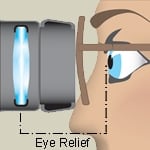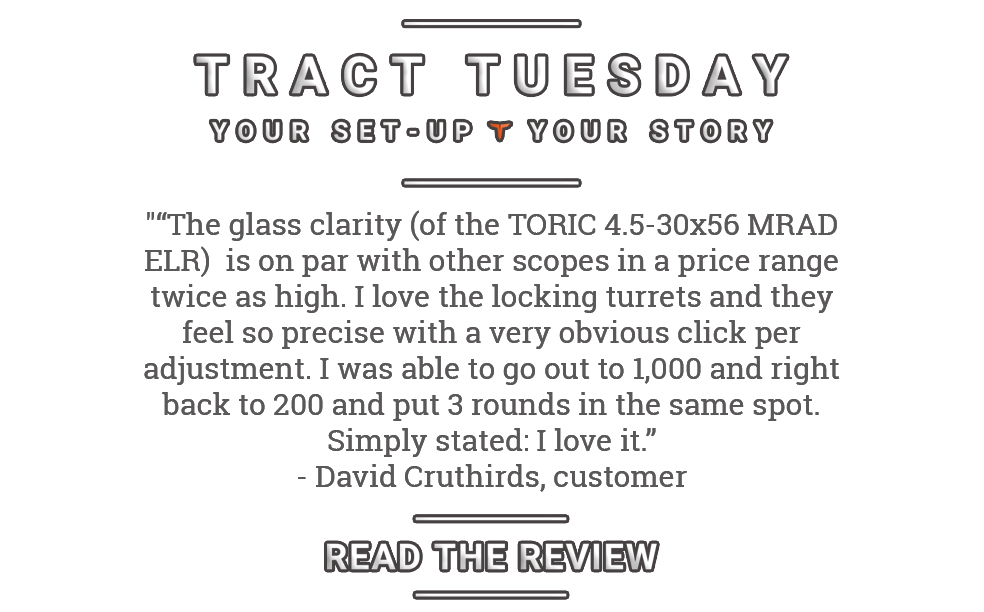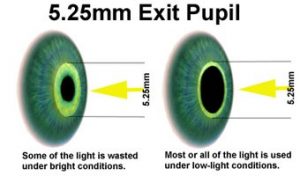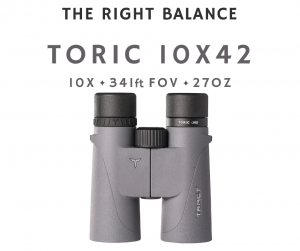When it comes to the debate of 8x versus 10x binoculars, you should define where you’re hunting and what you’re hunting to determine what size is best for you.
Of the thousands of people we speak with each year, whether at shows, on the phone, or by email, virtually all gravitate to the 10x binocular. The universal consensus is that the 10x has to be better because of its higher magnification. Many hunters, shooters, and birdwatchers argue that being able to bring an object 10 times closer versus 8 times closer is the most important aspect of a binocular. The answer, really, is yes and no. So, let’s take a look at the facts in order to help you determine what size may be best for you.
Image Stability 8x Versus 10x Binoculars
Trying to hold a binocular steady while studying an animal at 200 yards is not easy. As human beings, the heart pulses that allow us to live will cause us to experience a bit of shakiness to the image. Especially when you add an animal to the scenario and must closely study every detail. Many western hunters rely on a tri- or bipod for their binoculars as they glass large expanses just as a birder might use a monopod when spending long days looking up into the trees. So, if you’re using a 10x binocular, which will magnify the image by 10 times, will also magnify the shake in your hands by 10 times.
Here’s a little test you can take to compare 8x versus 10x binoculars. Tack a dollar bill on the wall about 20 feet away and try to read the serial number. Start with a 10x binocular. Oftentimes, you’ll shake so much that the task is nearly impossible. Next, take up an 8x. And while you’ll still notice some shake, you’ll notice that the movement in the 10x is exponentially greater.
It’s important to understand that just because the image is bigger doesn’t mean you can verify detail. So the truth is, if you can’t hold a 10x binocular steady, you will actually get better results in the field with an 8x. The advantages of a larger image are sometimes not practical because your every movement is also magnified.
Field of View
Field of View (FOV), as defined by Merriam-Webster, is the area that can be seen when you look through a telescope, binocular, etc. Say you’re looking through a binocular at an object that’s 10 feet away. You’ll notice how small the area around said object is. Back up to 20 feet and the area around the object is twice as large.
If you ask yourself, “why would I be able to see more with an 8x than with a 10x?” The answer always comes back to FOV. For example, when comparing the TORIC Flagship 10x42 vs. the 8x42, both have the same Ultra High Definition optical system, magnesium alloy body, and virtually the same height and weight. But, less magnification, which is the 8x binocular, means you’ll have a much larger FOV.
Check out the chart below and you’ll see that our TORIC 8x actually gives you a 10 percent wider area than the 10x (377ft vs 341ft):
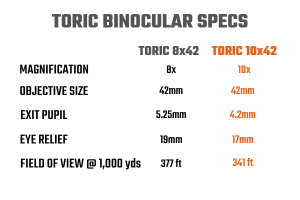
8x Versus 10x Binoculars
Let’s continue to dive in a bit further by using a practical hunting situation. Imagine you’re hunting the eastern hardwoods for whitetail deer. Generally speaking, a wider field of view will make it easier to spot a deer moving through the thick branches and underbrush because you’re seeing a much bigger area through the binocular.
In the photo below, the magnification is greater on the right, with a 10x binocular. But all you can see is a small portion of the deer. Notice in the picture on the left how the wider FOV allows you to see the animal much easier. All you need to locate a whitetail is catch a subtle movement in the brush like the flicker of a tail or ear. If you’re hunting east of the Mississippi River, it's easier to locate a deer with a lower-power binocular and a wider field of view.
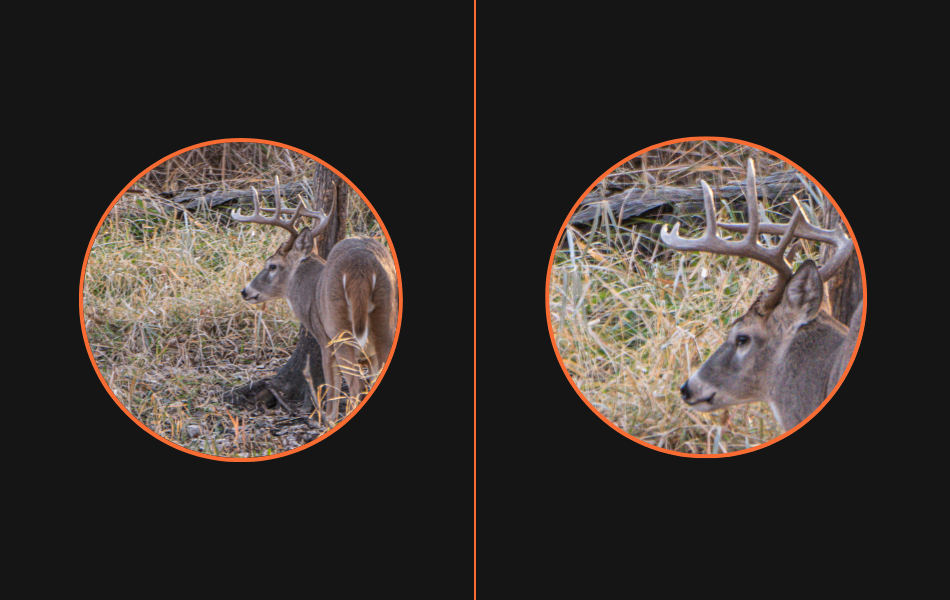
A Large Field of View (FOV) in heavy brush or timber can make a difference when trying spot movement.
Eye Relief
According to the Vision Council of America, 64 percent of Americans wear eyeglasses. If you’re among this bunch, have you ever noticed how your glasses tend to prevent you from seeing the full image through a binocular? Eye relief is what let’s those of us who do wear glasses use a binocular unhindered.
Really, you'll want to pay special attention to the eye relief specification on any binocular, especially when considering a 10x. For those who wear eyeglasses, 16mm of eye relief is the absolute minimum. However, it’s optimal to get a binocular with 17mm to 19mm of eye relief so you can see the entire FOV the binocular was designed to allow. In the TORIC Binocular specs chart above, you’ll notice that the TORIC 8x42 provides an incredible 19mm of eye relief vs the 17mm on the 10x, which comparatively speaking is excellent for a 10x.
Eye Relief is the distance your eyes should be from the binocular eyepiece for you to obtain a full viewing image.
Light Gathering Ability
The incredible design of a human’s eye pupils are what allow us to gather or reject light based on the lighting conditions of our surroundings. Your pupils will open to 5-7mm when the light starts to diminish, hence the reason you can see in the near dark. On the contrary, your pupils will shrink to almost 2mm during bright-light conditions to protect your cornea.
However, binoculars are not built that way. The light gathering ability of a binocular does not change, so it’s important in the debate between 8x versus 10x binoculars that you know the facts. The amount of light can vary greatly throughout the day and into the night. The size of your entrance pupil can change in size from as little as 2mm to over 7mm in diameter.
At the key hunting times of dawn and dusk, your entrance pupils are around 4-5mm in diameter. Since most of us hunt in low light, you’ll need a binocular that meets or exceeds the size of your entrance pupil during the time you plan to use it. The TORIC 8x will give you 5.25mm of light vs. 4.2mm from the 10x.
We know this by measuring the size of the binoculars exit pupil. The exit pupil is the actual image in the eyepiece as it leaves the binocular to enter your eye. A more technical definition of exit pupil is the diameter of the shaft of light (expressed in millimeters) that exits a binocular’s eyepiece that can enter through your eye’s entrance pupil. Exit pupil is calculated by dividing a binocular’s objective size by its magnification. For example, 42mm/8x = 5.25mm or 42mm/10x = 4.2mm.
Under bright light, your pupil may contract down to 2mm, causing some of the light that emanates from a 5.25mm exit pupil to go unused because it’s blocked by the iris (above left in diagram). However, under dawn and dusk conditions, your pupil will dilate up to 5mm or more (above right). Thus, an 8x42 binocular will deliver the maximum amount of light that your pupillary opening will accept.
Decision Time
Now you have the facts. For these conditions and uses, I’d save the $10 and buy the best 8x42 binocular the hunting community has ever seen: the TORIC 8x42 with 377 foot FOV, 19mm of eye relief and 5.25mm exit pupil. Enjoy my friends.
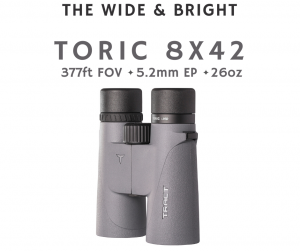
8x Versus 10x Binoculars. When it comes to the debate of 8x versus 10x binoculars, you should define where you’re hunting and what you’re hunting
If you’d like to discuss further, you can reach us via email, phone, or chat.
- email: [email protected]
- Phone: 631-662-7354
- Chat online: tractoptics.com

